How to Increase Your SaaS Revenue
The Essential Guide to Driving SaaS Sales and Reducing Churn

Matt Francois
CEO of SaaS Tune

If you're running a B2B SaaS company, there are three fundamental ways to increase your revenue:
- Get more customers.
- Get the customers you already have to pay more.
- Lose fewer customers.
Summarizing the problem this way makes it seem simple, but it can be incredibly tricky to solve in practice.
For example, what's the most straightforward method for improving revenue growth without making big-budget investments?
Increasing leads is the first thing most folks try. Regardless of Customer Acquisition Costs (CAC), putting more qualified leads in at the top of your funnel will increase your numbers throughout the rest of your marketing and sales processes. More leads means more customers.
Next, you could focus on increasing Average Revenue Per Customer (ARPC). After all, it's much easier to sell someone a second time, especially when they've already seen the value of your product. You already have email addresses, usage data, and plenty of other material you can use to target offers that will increase customers' Lifetime Value (LTV).
Finally, you might try reducing your churn rate. Churn is the hole in the bucket through which customers slip, taking the recurring revenue they represent with them. It's the "SaaS killer," the silent, slow disaster that overtakes most SaaS companies. It will undermine your efforts even as you chase leads, maximize conversions, upsell as much as possible, and raise capital every chance you get.
Here's what these three aspects of revenue look like for a typical customer:
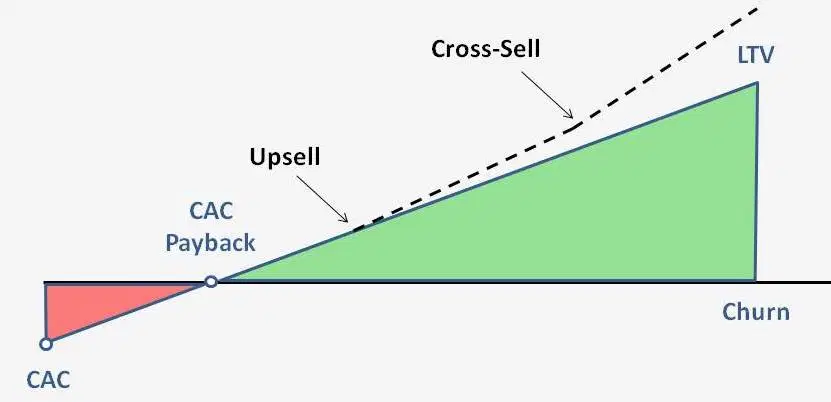
This chart highlights several good places to focus your revenue-boosting efforts. But before you jump in and start changing things, we need to talk about where your underlying revenue problems come from in the first place.
In this guide, we'll explore the most common revenue problems B2B SaaS companies face. I'll provide practical solutions to these issues, ranked by how quickly you can implement them and their overall impact on your bottom line.
You'll learn:
- Short-term steps you can take right now to increase revenue immediately.
- Medium-term solutions that will resolve deeper underlying revenue problems, yielding more significant improvements.
- A long-term shift in mindset that will change the whole way you look at your funnel. This change in thinking will sharply reduce your churn, increase the effectiveness of your marketing funnel, and drive adoption across your entire user base, all at once.
Let's start with some essential solutions that you can put into action right now.
Quick SaaS Revenue Fixes
Decrease Churn Right Now
The best way to immediately address churn is to identify pre-churn customers by red-flag behaviors and then reach out to them before they're gone forever.
This works because the process of losing customers starts well before they cancel their subscriptions. As you can see from the graph below, if you wait until you have data on actual unsubscriptions, you'll be gathering data when it's too late to act:
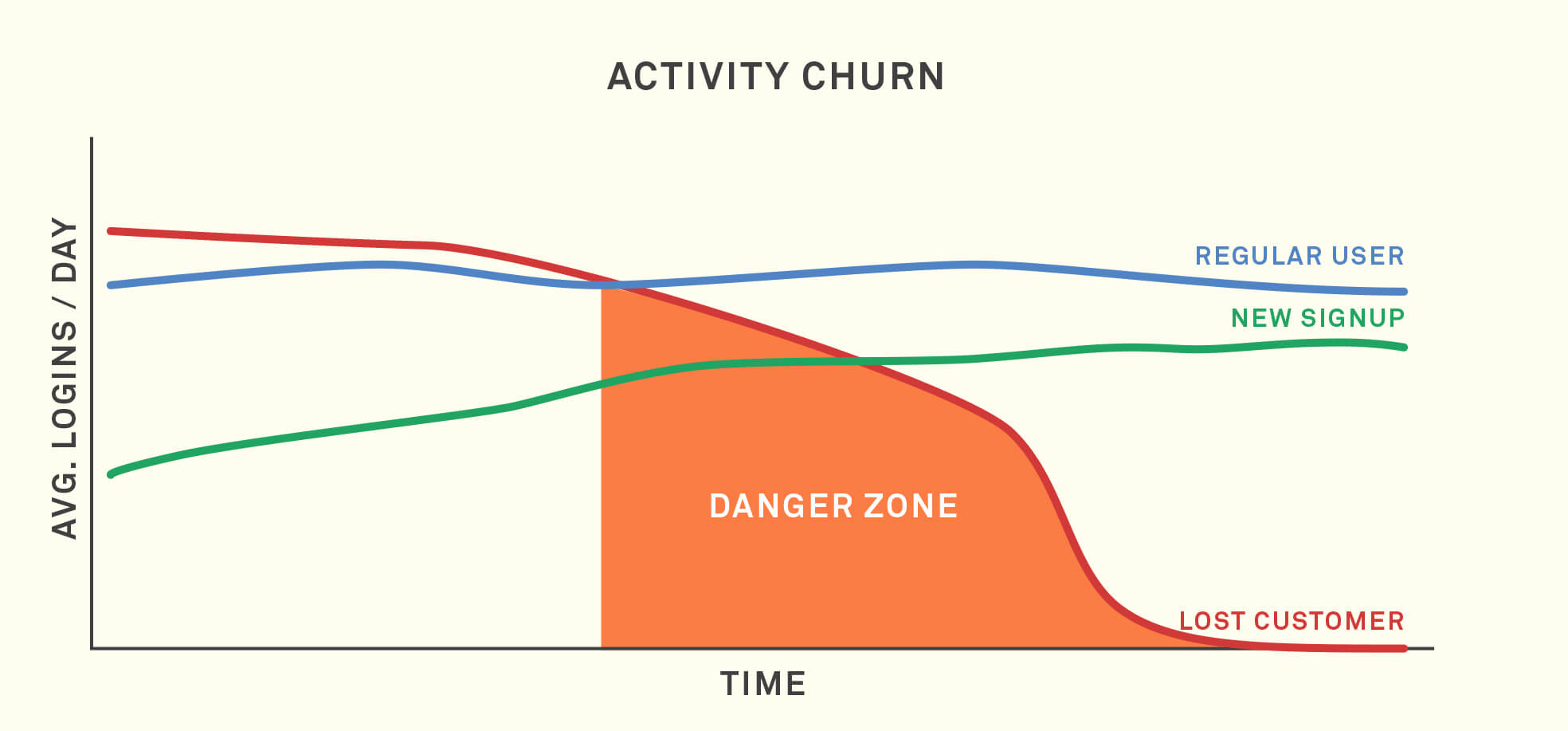
Inactive customers are far more likely to churn. So the focus should be on re-engaging customers who have become less active or completely dormant.
As soon as average logins or time spent active begins to decline below the regular-user level, you should actively re-engage — with emails, in-app push messaging, and more.
The way to get this wrong is to target individual users whose usage suddenly drops, with messages aimed at them alone. Reaching out with "Hey buddy, we miss you!" won't do much. That's because the reason Scott hasn't logged on in a week isn't that he's quit your product; he's on vacation.
Instead, watch for team-wide or organization-wide reductions in activity, and ignore individual anomalies.
Re-engagement is a tricky subject, and it's easy to get tripped up like this. So let's look a bit deeper into the best way to handle disengaged customers.
Nailing Re-engagement
Most of the material out there regarding re-engagement is about surface-level approaches like emailing people to remind them you exist. If you're a consumer-level language learning app, that probably works great. It certainly seems to be Duolingo's go-to method.
But for B2B SaaS, you're not dealing with people who got bored or forgot about you. After all, they're still at work.
So what changed?
Did they:
- Find a competitor who does what you do better or cheaper?
- Stop doing the thing they needed you for?
- Start finding you more a hindrance than a benefit?
In general, churn is caused by 1) your customers not deriving enough value from your product or 2) your product requiring too much effort for them to use. So, these problems are what you need to address first.
Increase Your Product's Value
Value comes first, so start creating email templates that address upcoming product improvements that will make your customers more successful. For instance, you can mention better integration with the users' core stack or super-common tools like Google Workspace or Office 365.
If you can, segment your user base and offer reduced-activity customers re-engagement materials based on their industry. Your upcoming integration with Adobe is big news for your design customers, not so much for the accountants.
Reduce the Effort Required to Use Your Product
A non-intuitive or difficult to use product is often something reduced-activity customers will tell you about themselves. How many support tickets do they have open? Open tickets and reduced activity means dissatisfied customers, so have someone in Support take a look.
Grab all those tickets, and contact that customer from a named account. Take responsibility, tell them how you're fixing their issues, and talk like a person, not a "dear valued customer" auto-mail.
And of course, you need to actually fix the parts of your product that are the most difficult for your customers to use.
Improve Average Revenue Per Customer Today
A short-term fix for lagging per-user revenue is identifying "upsellable" users by firmographics or behavior, then targeting them with value-oriented sales outreach. The simplest way to do this right away would be to sell more higher-value plans.
Suppose you were SurveyMonkey, making $84 million in Q4 2019 from 720,921 paying users, averaging $467 per user.
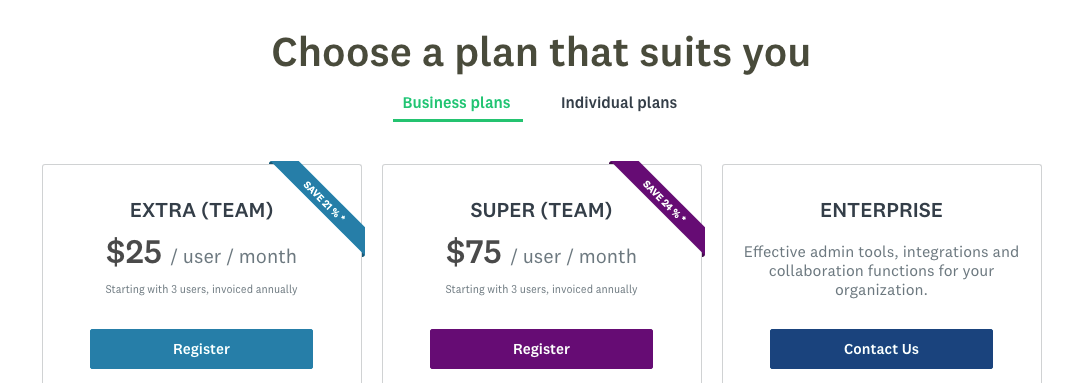
What would have a significant effect on per-user value?
- Moving users from Extra to Super (increasing their value by 200%)?
- Moving users from Super to Enterprise (increasing their value by about 100%, since SurveyMonkey's per-user average value works out around $155 per month)?
- Moving users from non-paying to paying?
Unless you look closely, what's not apparent is that there's a crucial fourth option:
- Move paying users over to annual business subscriptions.
Here's what SurveyMonkey actually did, compared to Q4 2018:
- Increased paying users by 11%.
- Increased annual subscriptions by 9% (all business subscriptions are annual-only).
- Increased enterprise sales revenue by 13%.
The result? 10% revenue increase over Q4 2018.
SurveyMonkey didn't do this by just emailing their customers and offering to charge them more money. Their success resulted from converting regular customers to higher-paying plans and from targeting enterprise customers who were most likely to enter into high-value, long-term contracts.
This is a form of customer targeting we'll get into in more detail further down. First, though, let's look at short-term revenue boosts for the top of the funnel.
Increase Customer Acquisition Immediately
Driving customer acquisition in the near term broadly means boosting traffic and top-of-funnel conversions. But without addressing more in-depth metrics like Lead Quality, Lead Velocity, and Long-Term Value (LTV), you're going to wind up with "the same, just more." That is, if you're converting at 2% right now, you could hope to convert at maybe 2.5% to 3%.
For the record, converting visitors to leads at 2% is a solid conversion rate for SaaS companies:
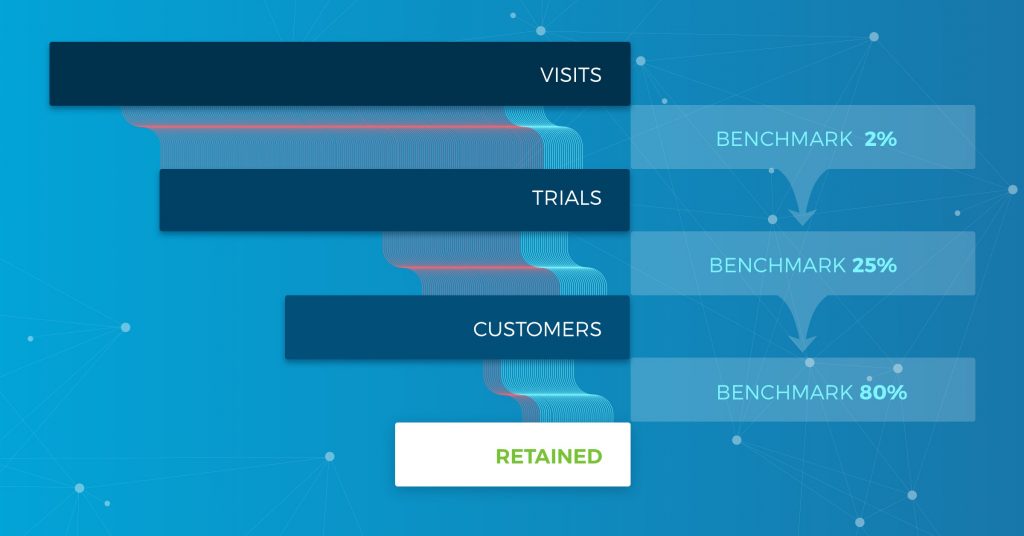
To get better results, you need to dig deeper than just driving more traffic. But that's a strategic consideration that takes time and effort. We'll get into more complete solutions shortly, but for now, here are some quick wins you can implement right now to increase traffic and conversions.
Increasing Your Traffic Today
To start with, check through your website for basic errors. Look for:
- Title and header tags that are missing, duplicated, too long, or too short.
- Meta descriptions that are absent, too long, or don't make sense. Your meta descriptions are your chance to convince search engine users to visit your website; write them that way.
- A website layout that’s messy. Are your URLs sensible, descriptive, short and logical? Or do you have stuff like yourcompany.com/blog/content/miscellaneous/hr/hiring/whatever-the-post-is-actually-about-but-exactly-the-same-as-the-headline/?
The next thing to check is your content. If you have some content, and it performs — i.e., you get traffic and conversions out of it — head over to it in your CMS and look to:
- Improve keyword density, accuracy, and placement. Put crucial keywords inside header tags and the initial and final paragraphs. Don't stuff it anywhere it fits; use it intelligently to emphasize the page's topic to Google.
- Check quality, relevancy, and scope. Everyone's heard the "blog posts with 1,500+ words perform better" tip. That's because those longer posts answer the reader's questions better and in more detail. Taking 300-word posts to 1,500 can bump them up a few places on the search results page. Structure them sensibly and make sure they contain more detail, information, and value — not just more words. And critically, don't change the URLs; just republish.
Finally, if you're using Google Ads, LinkedIn Ads, or other paid advertising channels, check through them, looking for big wins at low cost. In most cases, ad spend is too spread out, keywords are too general, and well over half of budgets are wasted or suboptimally spent. Fixing this could double your effective ad budget without actually spending a penny extra.
Follow the leads you get from ads a couple of levels into your funnel if you can. Otherwise, you could wind up doubling down on ads that cost little and generate tons of leads, none of whom ever become real customers.
Increasing Your Conversions Today
The number one method for rapidly increasing conversions is to ask for them more frequently, closely followed by asking for them louder and more clearly.
Unfortunately, many SaaS websites don't have a sufficiently prominent Call to Action (CTA)
Let's look at the three elements of an effective CTA: placement, design, and copy.
CTA Placement Best Practices
Make your CTA tough to miss. A good rule of thumb is to put it at the bottom, top, and throughout every page's content. For instance, under the introduction and one to three times throughout a blog post.
Keep in mind that you're having a conversation with your customers on your landing page or homepage:

If the "Above the fold" section is telling them how great your solution is for solving their problem, some visitors might think, "Sounds good; I'll try it," and click through.
Others might need more: attention to their specific pain point, information about how your tool interacts with others in their stack, use cases, positive reviews from peers, and so on.
Each is a potential conversion point because each should handle a visitor's possible objections and convince them to click through. So make sure you're giving them a CTA to click.
CTA Design Best Practices
CTAs work best in buttons, usually though not always rectangular, that visually stand out from the rest of the site. Consider using a tool like Cohesive Colors to help select a good color scheme for your buttons.
"Design downhill" — make it as easy as possible to find and click your buttons. Don't put them in sidebars where ad blindness will stop people from seeing them, and don't color them the same as non-conversion elements.
CTA Copywriting Best Practices
Make it clear what happens when you click through, so there are no surprises. "Try it now" should lead to a trial — not to an interstitial or a purchase page.
Make CTA copy active: "Let's go," "Get started," "Try it now free." You want the user to feel that by clicking through, they're taking control.
Check out these top CTA picks from Hubspot to help if you're unsure.
Broader SaaS Revenue Solutions
Okay, so we've covered some quick short-term actions you can take to increase revenue. But what about taking a more strategic approach? Let's address the most effective medium-term actions you can take to increase your SaaS revenue.
Addressing the Underlying Causes of Churn
To fix churn at a deeper level without making radical changes to your whole funnel, you need to look as far back into your existing process as possible.
You'll need to gather customer data from the Customer Acquisition Stage, throughout the Onboarding Stage, to the Customer Success Stage (and ideally, beyond).
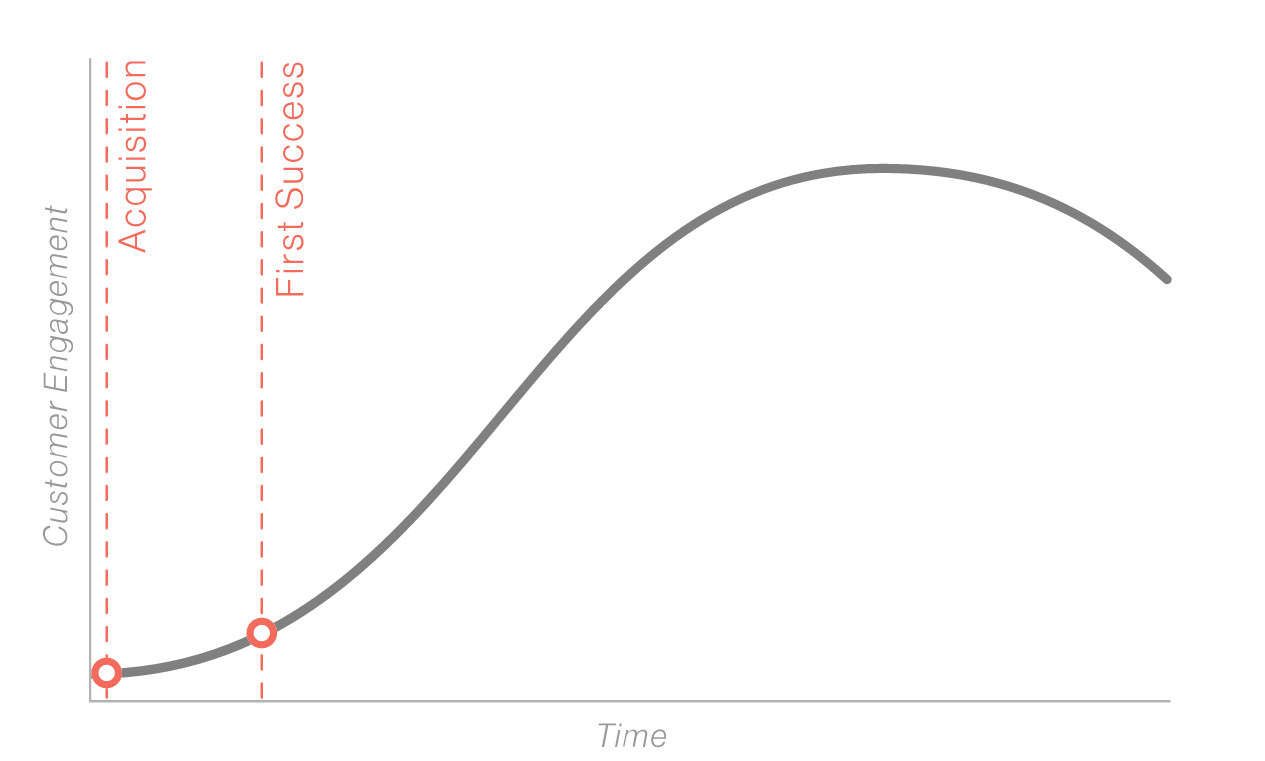
In consumer SaaS, churn mostly takes place between sign-up and success. Something happens that prevents the customer from achieving their goals with the product.
For B2B SaaS, the situation is similar but more complicated: both the individual user and the company have to achieve success to drive retention. And both will measure success somewhat differently.
Users measure success by the emotional experience of solving a pain or problem. Fix the rock in their shoe, and you'll have a convert. But for businesses, they're looking for measurable business value. You have to hit both to be successful.
The easiest win here is to use data to build effective Customer Success into your product's onboarding process.
Examples of Success-Oriented Onboarding
Suppose you have a tool like FYI that lets you search among all your apps and storage tools for work documents, thus saving time.
For onboarding to be effective, it should be simple for your customers to connect their apps to the product during sign-up:
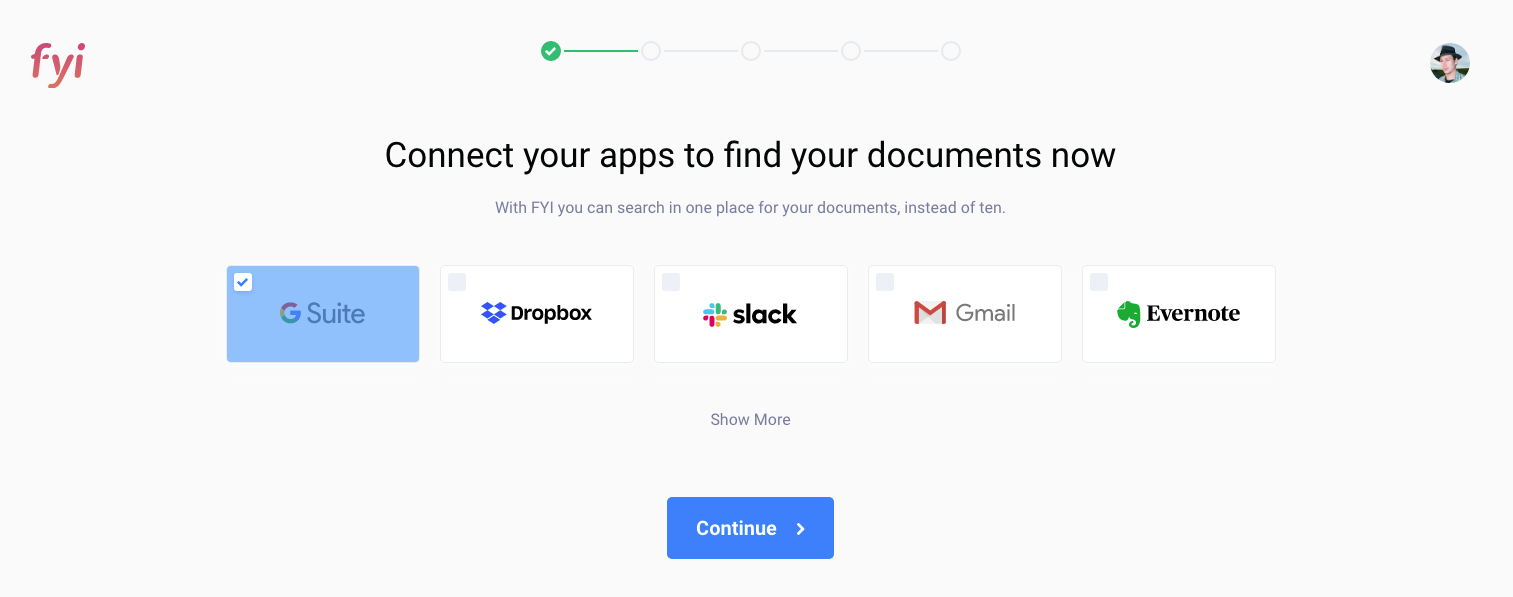
At the top, there's a progress bar, so you don't feel you're stuck in a never-ending test of your patience. Later on in the flow, you're encouraged to install the Chrome extension and then taken directly to your apps' activity feed.
A guided flow like this helps the customer get directly to the value of your product as soon as possible, almost effortlessly.
Alternatively, you can try offering onboarding as a value-added service. Slite, the company knowledge base and communications app, has a pretty typical SaaS sign-up page:
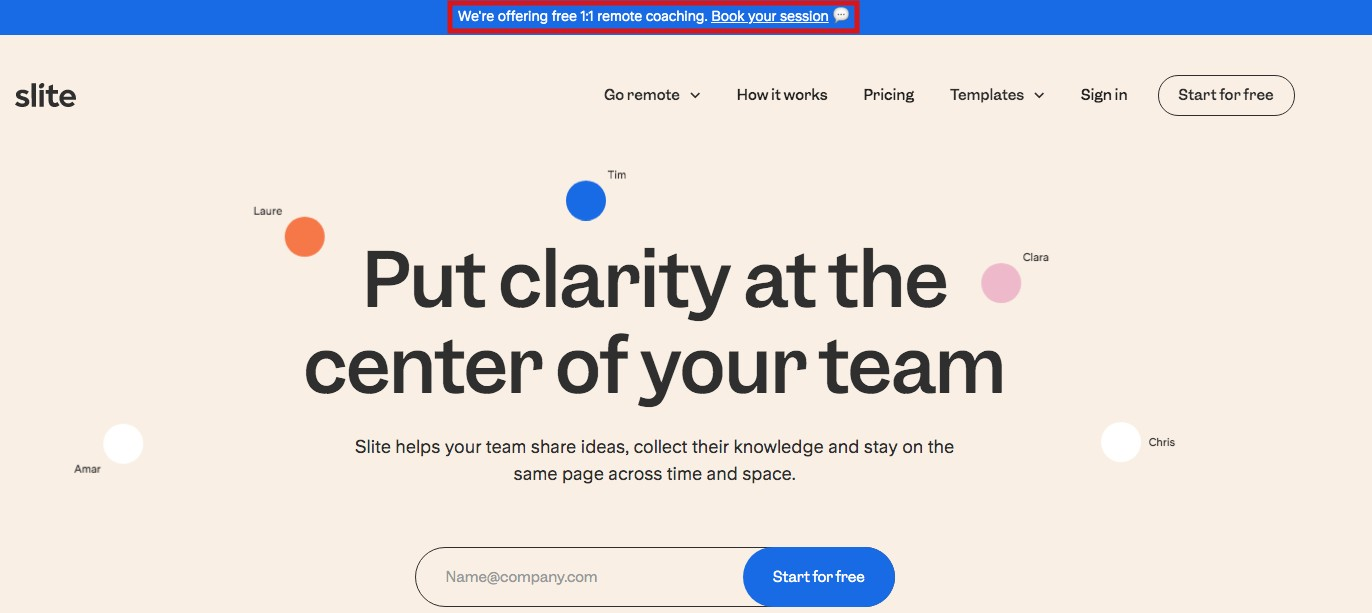
But if you look up at the top of the page, you'll see an invitation to free one-on-one coaching for using the product. Of course, that's not really free: Slite customers pay for it in subscription fees when they stick around and use the app.
But they're more likely to have success with the product after completing coaching, so this style of guided onboarding is a big win for the individual customer, the business they work for, and for Slite.
You can build onboarding flows like these through a data-backed process of trial-and-error — repeatedly recognizing where customers are blocked from achieving success and then fixing the "hole in the bucket".
B2B Customers Want Their Employees to Succeed
B2B SaaS companies should note: your customers want their employees to achieve success with your product. One of the biggest struggles business software buyers have is getting staff to use the tools they purchase; HBR was talking about it in 2015, and in 2020, not much has changed.
Businesses are shifting their focus from mandating usage to "selling" their employees like consumers. As this happens, they'll want to be supported by effective onboarding, so building a ramp to individual customer success is the quickest win at the individual and institutional level.
A More Thorough Average Revenue Per Customer Solution
Increasing per-user revenue in the medium term involves looking at the customers you already have and figuring out which of them are carrying most of your business.
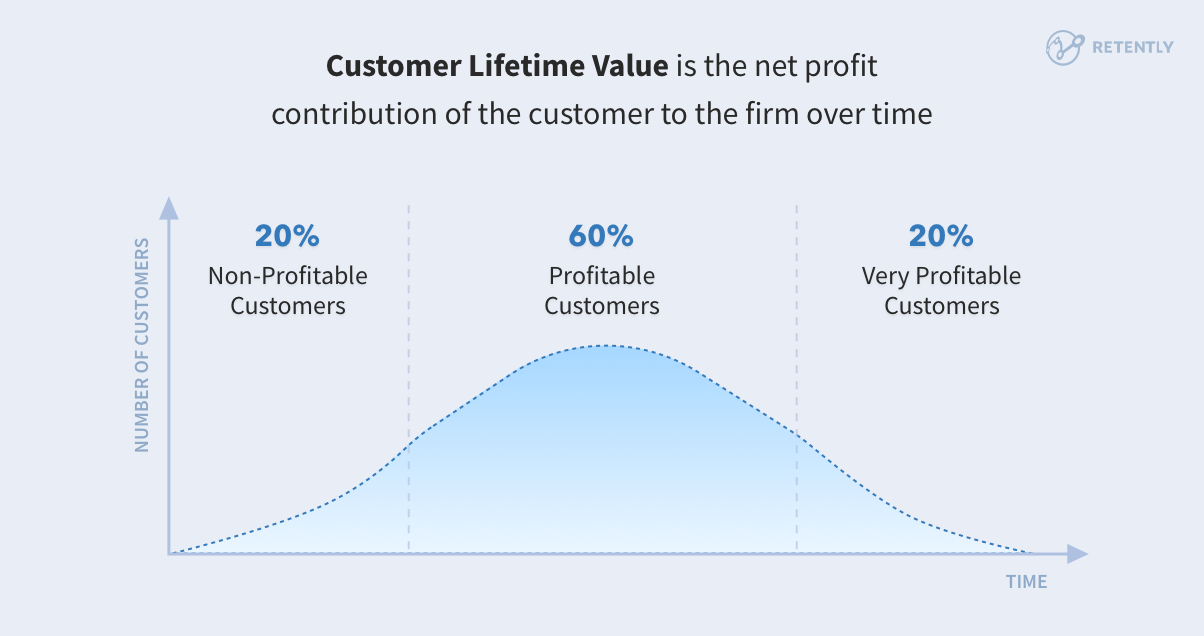
You'll likely find that around 10% to 20% of your customers provide the majority of your revenue and profits. It's the Pareto principle in action — 80% of your rewards come from 20% of your efforts.
So, look for enterprise or power user customers, ones that combine high activity with multiple logins per day, long contracts, and high-priced plans.
Then look for what else they have in common. Ideally, you're searching for a small number of decisive behavioral factors that earmark users as "super-customers." You can use these factors to target them for upselling.
To do this, you don't have to invest in "big data" or highly-granular analytics. You should be able to do it with a spreadsheet because the difference in Long-Term Value between your best customers and everyone else should just jump out at you.
Next, find out what happened to make these customers so profitable. What moved "biz.io" from their $25/month subscription to their $125/month subscription?
Figure that out and then make it happen for just one more customer, and you'll have had the same effect on immediate revenue as making four new sales.
In practice, this means you should be looking for the functionality that would persuade existing users to step in with both feet, then figure out the easiest way to provide it. In some cases, it's integration with some element of their existing stack or workflow. In others, it's an extensive knowledge base that functions as an upselling and Customer Success tool.
One example is Ahrefs' blog. Ahrefs has grown ARR by 65% two years running, mostly using their blog, which explains how to use Ahrefs to achieve SEO and marketing objectives. It's dry, technical, but hugely effective. When users promote themselves to higher-priced subscriptions, often it's because they read about something in the Ahrefs blog that they couldn't do with their lower-price subscription.
It's also worth stealing another page from Ahrefs' book: they have a severely limited, fairly-expensive basic plan:
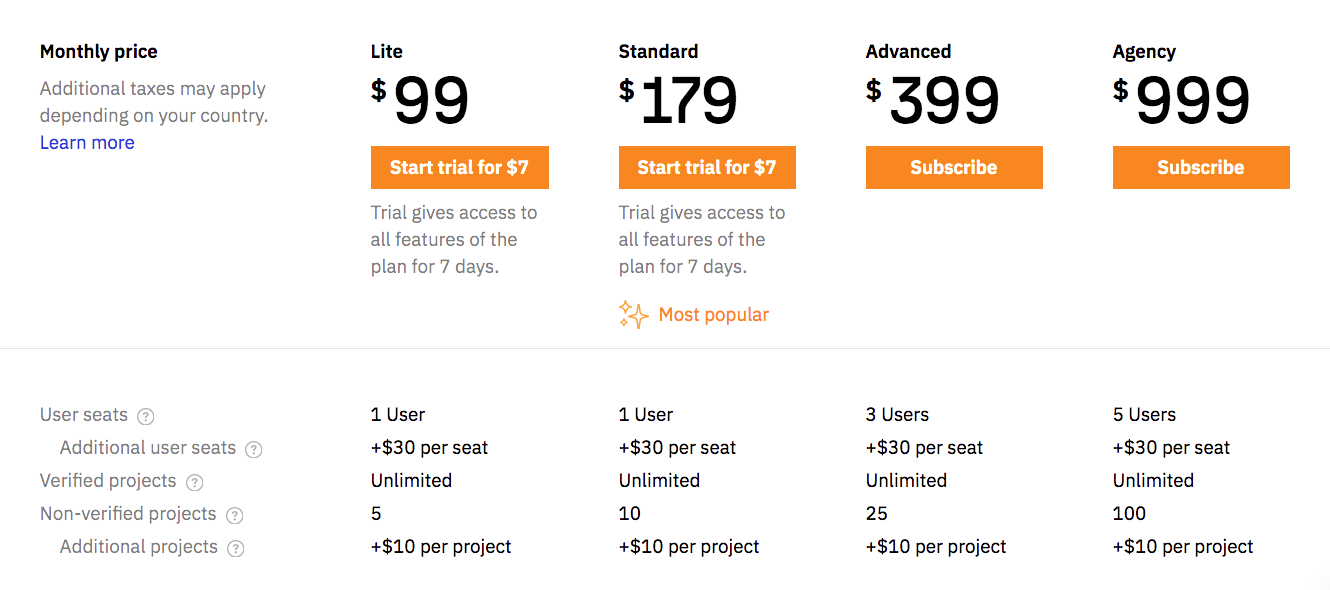
At first glance, the chasm between those plans isn't apparent. But Lite users only get access to the top 10 results in many Ahrefs reports. It's enough to get a general idea of how the tool works, but not enough to do a comprehensive analysis like in the full version. Some other numbers are different, as well:
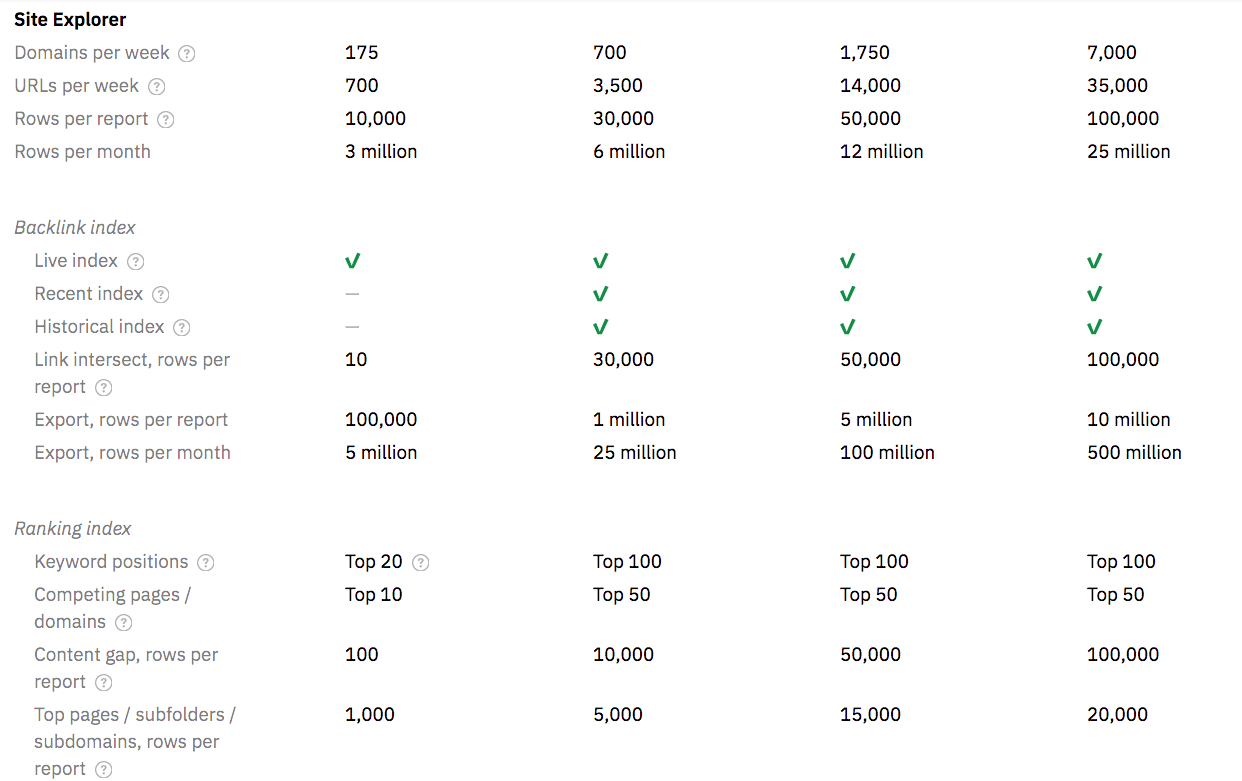
There's no free plan, just a 7-day trial that requires a credit card. The result is a much sparser Top of Funnel that contains no-one who isn't 1) serious about technical SEO, and 2) ready to spend money.
There's value in qualifying sharply like this to improve customer value right from the start.
Better Customer Acquisition
That brings us neatly to customer acquisition in the medium term. How do you drive customer acquisition without getting right under the hood and totally redesigning everything? We're still looking for strategic fixes that aren't too radical.
The first place to look is Lead Acquisition, right at the very top of your funnel.
Attract the Right Leads
Let me ask you: How much of your website traffic results in real leads?
That's a serious question. Most SaaS websites build their marketing funnel around website traffic, which they'll then try to convert. They're looking at traffic with one eye and conversions with the other. So when traffic rises, they cheer. "Yay! Now we can convert our traffic to sales!"
Maybe, maybe not.

In the blog post Going from 0 – 3851 Instagram followers in 37 days!, veteran marketer Dan McGaw explains how he drove an enormous number of people to his Instagram account. How? He took advantage of an escaped snake that was making headlines in the local news.
Traffic skyrocketed, so, hooray — but unfortunately, there was no way to convert that traffic because it was inappropriate for his business purposes. It was "bad traffic," and all the Conversion Rate Optimization (CRO) in the world couldn't get people from "haha snake" to "ten thousand dollar marketing stack integration? Tell me more."
It's the same with your offering. How much of your traffic is actually convertible, and how much is never going to become customers?
Let's say you have a website that gets 3,000 visitors a month, or 100 a day. You convert from visitors to leads at 2.35%, around the average for a SaaS site, meaning you get 70 customers a month:
3,000 visitors x 2.35% conversion rate = 70 conversionsIf you increase your conversion rate by just 1%, you'll have 100 customers a month:
3,000 visitors x 3.35% conversion rate = 100 conversionsIf each customer is worth $100 a month, it's an extra $3,000 every month, from that 1% conversion rate increase.
Phrased this way, it's easy to see why so many SaaS businesses cram as much traffic as they can into the very top of their funnel and then focus on increasing their conversion rate.
But another way you might try to get the same result is to leave the conversion rate at 2.35% and instead focus on increasing traffic numbers.
If you do that, then to get the extra 30 conversions every month, you'd need 4,250 visitors a month, right?
4,250 visitors x 2.35% conversion rate = 100 conversionsWrong! The problem with this analysis is that it ignores traffic quality.
Disruptive Advertising CEO Jacob Baadsgaard has released the results of over 2,000 AdWords audits, showing that on average, 100% of the conversions were derived from 6% of the keywords. The advantage of paid traffic is that it can be shaped easily and targeted precisely — yet 94% of keywords and 61% of ad budget was wasted!
Thus, if you're like most SaaS businesses, 94% of your paid traffic isn't convertible at all. The situation for organic traffic is likely to be about the same.
Suppose we apply those percentages to our hypothetical situation above. In that case, you can see that 6% of visitors (or 180) can be converted:
3,000 visitors x 6% possible to convert
= 180 qualified visitors2,820 are wasting their time and yours. Technically, your 2.35% conversion rate is really a 38.9% conversion rate, based on the 180 visitors who were ever going to buy:
70 conversions / 180 qualified visitors
= 38.9% conversion rateSo, your priority should be to drive up the number of qualified visitors, not just traffic in general.
How do you do that?
Target high-quality organic traffic using SEO tools and analytics by identifying the longest-tail (most specific and granular) keywords your top-performing visitors respond to.
Treat these keywords like they are your would-be customers telling you what they want. Give it to them. Put those keywords in the title of your next blog post, video, landing page, or another piece of content.
At the same time, refine and retarget your lower-quality organic traffic. Look through your site and strip out content and pages that rank for never-converting keywords.
Only look at leads, not visitors! Remember, you want people interested in your product, not just your niche or some random keyword you're unaccountably ranking for.
This will reshape the whole way your site looks to search engines. It will reduce your time-wasting, non-converting traffic while boosting more relevant, quality traffic.
To do this faster, you can use paid ads to get a bead on traffic and conduct keyword "sculpting" to shape your organic traffic correctly.
Google Ads don't improve organic traffic directly. Still, you can use Google Ads campaign data to identify high-converting keywords instead of merely high-traffic ones. You can do this with campaigns costing just a few hundred dollars.
Nurture the Right Leads
The other place to address lead quality is mid-funnel. Here, you've already qualified out everyone who's uninterested. These people have signed up for a trial or, at the very least, given you their email address (check it's their real email as soon as you can!).
So conversion rates down here are much higher. The benchmark free trial-paying customer conversion rate is 25% — about 10 times the benchmark visitor-free trial rate:

Remember, too, that of the 2.35% of visitors who convert to a free trial, 75% will never pay a penny. The further down the funnel you go, the more a lead is worth, and the more a conversion is worth.
At this stage of the funnel, you can still use behavioral data gleaned from your best customers to separate the likely-best-customer leads and target them. Create an in-depth video, walkthrough, or white paper detailing your offering's most valuable parts and send it to leads who match your Ideal Customer Profile (ICP). Nurture these leads to convert them to paying and high-paying customers as early as possible.
Long-Term SaaS Revenue Growth
The short and medium-term methods we've discussed so far are effective, but they're not massive, strategic changes in the whole way you approach marketing, customer success, churn, and — well, your entire relationship with leads and customers.
You can expect 1% or 2% changes in results by relatively minor alterations and immediate short-term fixes. Get into the mid-funnel and medium-term, and changes like 10% or 20% are achievable if your execution is good.
But the enormous boosts, the 100%+ leaps in key metrics that occur when a business changes direction radically, are only available by making profound, strategic decisions that affect everything.
Lorn-term revenue maximization is about aligning your entire funnel with all of your organization's long-term goals.
Solutions to this can cost millions of dollars, involve cutting-edge Artificial Intelligence, and a stack of several big-budget tools. Do they work? Yes, if you use them right. Am I going to tell you how to do that? No.
Instead, I'm going to go over principles that you can implement without spending a dime and with the information that you're already gathering.
Why Many SaaS Companies Have Lackluster Revenue
SaaS companies don't get the revenue results they want for two reasons: they focus too much on short-term customer acquisition and not enough on thoroughly understanding their customers at all stages of their journey.
During each portion of the funnel, these companies treat their customers the same way, whether they're leads, customers and power users, or churners and returners. They treat customers as if they stop existing when they leave one stage of the funnel, then wink back into existence in another stage.
It's as if people cease to be leads once they hit Sales' CRM's final stage; now they don't have to sell to them any more: they're Customer Success' problem! Of course, that's until they have a question, at which point they belong to Customer Support.
In reality, it's the same person. Nothing has changed from their point of view. So to achieve long-term revenue goals, start treating them that way.
To make this shift in mindset, you're going to need useful data.
The Profound Importance of Good Data
If you've read this far, you've probably realized how important data is to the success of your SaaS business.
So it should be no surprise that you should be using the feedback churning customers give you to build both Ideal Customer Profiles (ICPs) and Customer Personas, including negative ones:
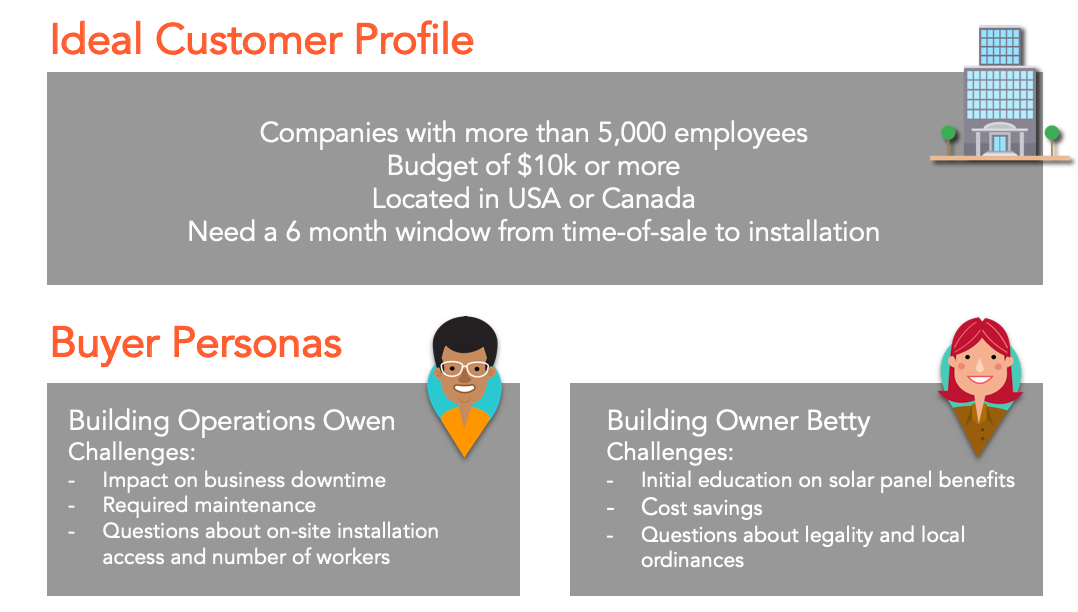
You want to take what you learn from churning customers and build Support and Success that keeps customers. And you want to use your data to create a Sales and Marketing process that attracts and converts customers — not just leads or traffic, but paying users.
Learn From Churn
Start treating everyone who has ever seen your product for themselves as churn and build structures to address why people leave. That includes creating customer profiles that incorporate learnings from lost customers.
As we saw previously, churn starts during the "Free Trial to Customer" conversion stage. So treat these people as leads and nurture them. If that doesn't work and they leave, find out why to reduce the loss.
You'll lose on average 75% of these leads and 20% of those who sign up for paying plans but never become real customers. Chase them as they leave and get data from them if you can't get anything else.
This gets more valuable the further down the funnel you do it, for the slightly counterintuitive reason that lower-funnel leads are worth more.
Data from churning users should even inform your Product Development. If you've lost three big customers because your product didn't integrate with Salesforce, Product and Engineering need to build that integration.
Of course, you'll never get churn to zero, in the sense that some customers will always leave. But the more you can find out about why they go, the more you can feed this data upstream into Marketing, Sales, Success, and Support.
Use Negative Ideal Customer Profiles
Negative ICPs are the businesses you want to actively avoid. These are the churning customers who tell you "We don't need a tool like yours." They were never a customer — maybe they got lost, perhaps they were just curious, but they weren't going to become a paying customer, ever.
Start using data acquired from churning customers to construct negative customer profiles that identify the customers you don't want. At every funnel stage, identify these customers and stop wasting time and resources on them, so you can focus on the ones who will be valuable customers. Do this with the same zeal as with your positive customer profiles.
How to Gather the Right Data
What's the best way to gather customer feedback? Net Promoter Score (NPS), exit surveys, and direct qualitative feedback.
Net Promoter Score
Net Promoter Score is a one-question survey: "Would you recommend us?" Because it's almost effortless to answer, it gets high response rates, even from people who wouldn't usually bother to fill out a survey. It's ideal for getting some usable data direct from churning free-trial customers. If you're collecting in-app usage data, you can compare it with NPS to obtain a quadrant like this:
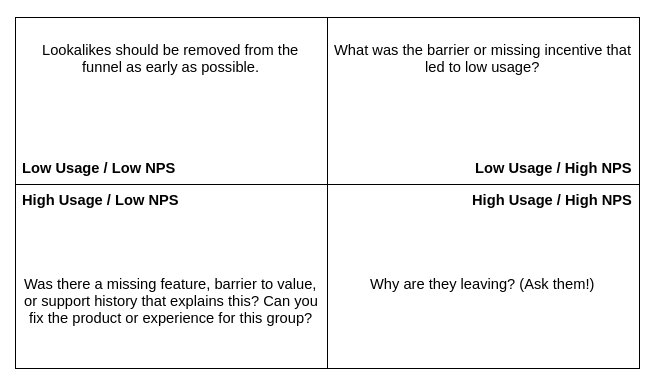
Most people who use your product and would recommend it would stick around if they could. If you see them leaving, retarget them with offers, paths to value, and more detailed surveys that ask them, "If you like it here so much, why don't you stick around?"
Exit Surveys
People who give low NPS scores might not fill out exit surveys. Try them anyway: you might get a recurrent complaint that lets you know what to fix.
People who give high NPS scores should be asked for more information, including:
- What did they find most useful about the product?
- Why did they decide to stop using it?
- Are they headed for a competitor? If so, which one, and why?
Try using an exit survey that looks like this:
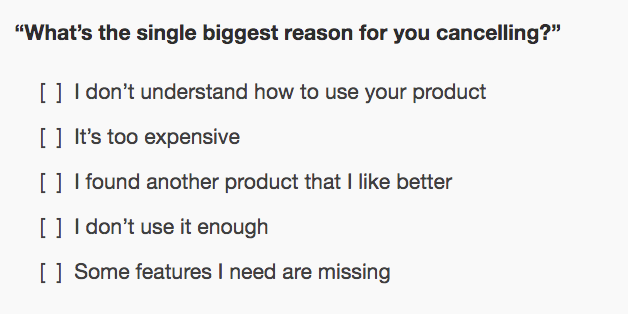
I'd even add an option at the bottom to get more information — "Tell us more" or any other open-ended question.
Qualitative Feedback
Improving your revenue long-term necessitates using all manner of data to make decisions.
For instance, don't leave your Product team to make changes to User Interface (UI) and product features in a vacuum. Instead, back up these decisions with the feedback you get from customers, churning users, and even leads.
That's qualitative feedback ("What was it like?") instead of quantitative ("How much of it was there?"). Qualitative feedback typically comes in the form of open-ended survey questions.
The degree to which you seek this feedback should be proportional to a customer's importance to your company. Seeking qualitative feedback is costly in terms of time, and it's tough to automate; it works best when it takes place between people. So you can't afford to do it for every free-trialler who drops out of the funnel.
But for real customers who leave, especially ones on high-price plans, you should get in there and seek the opportunity to talk with them about the reasons behind their decision. This is "sales in reverse." Just like you'd throw the CEO at a big client you wanted to catch, you should consider getting someone senior to approach a churning customer and ask open-ended questions. Try something like this:
I'd love for you to stay a customer, but I'm not looking for an opportunity to change your mind. I'm asking as a favor if you'll give me ten minutes to help me work out how I can do better for my customers.
It's hard to say no to that, and the info you'll glean from a real conversation with a decision-maker at a churning customer's company is gold dust. These are the people who will tell you about usability problems, complex process issues, stack integration hiccups, and loads of other things that will not show up in even the best exit surveys.
These conversations will change your life as a business and give you the data you need to target messaging and product changes to your ideal customers most accurately.
Build a Holistic View of Your Customers
The point of all this data collection is to align your whole funnel and create a single view of your customer's entire journey:
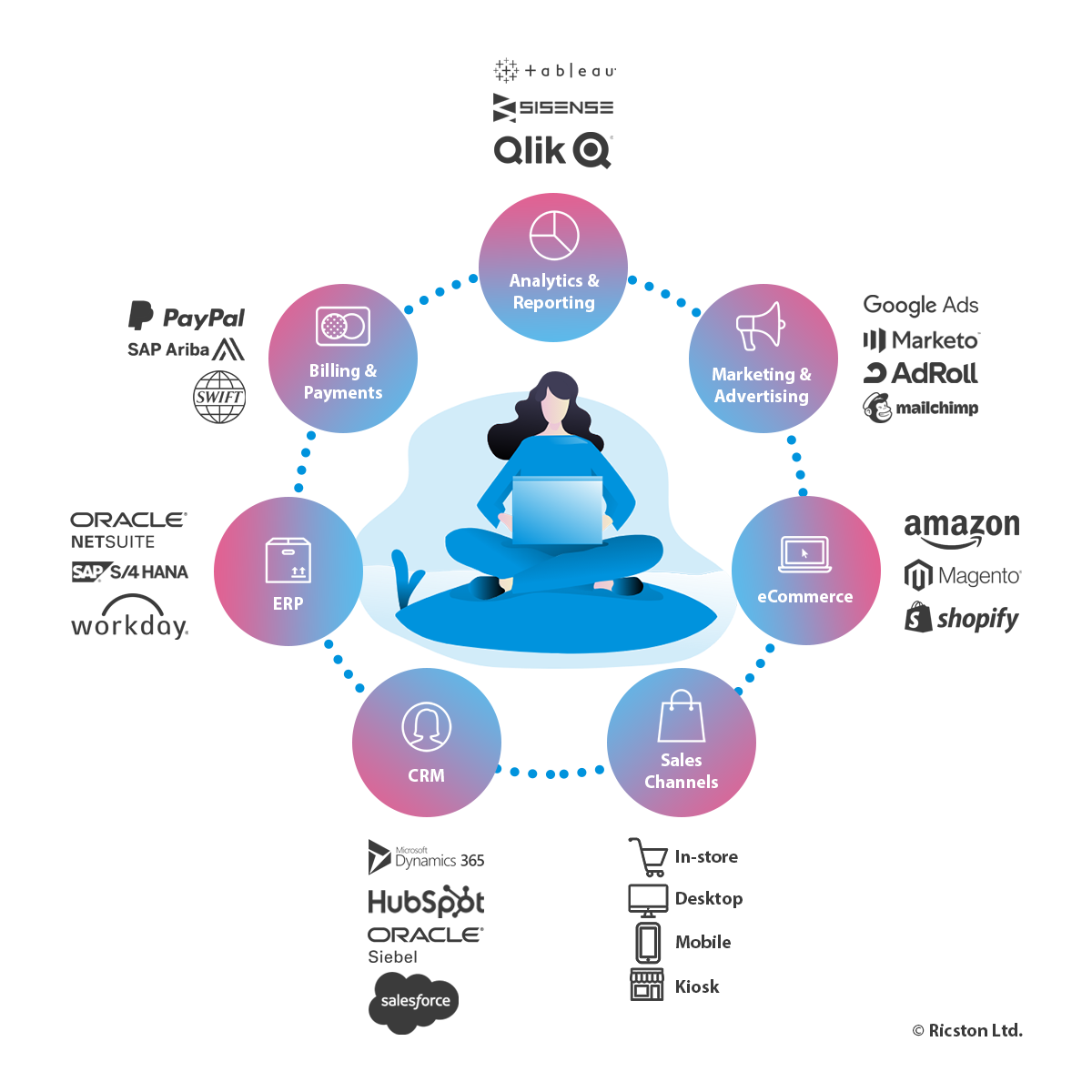
This is a very different way to look at your customer than the more traditional funnel view. We're so used to calling the sales and marketing process a "funnel" that it's second nature, but it's anything but funnel-shaped. This is a traditional funnel:
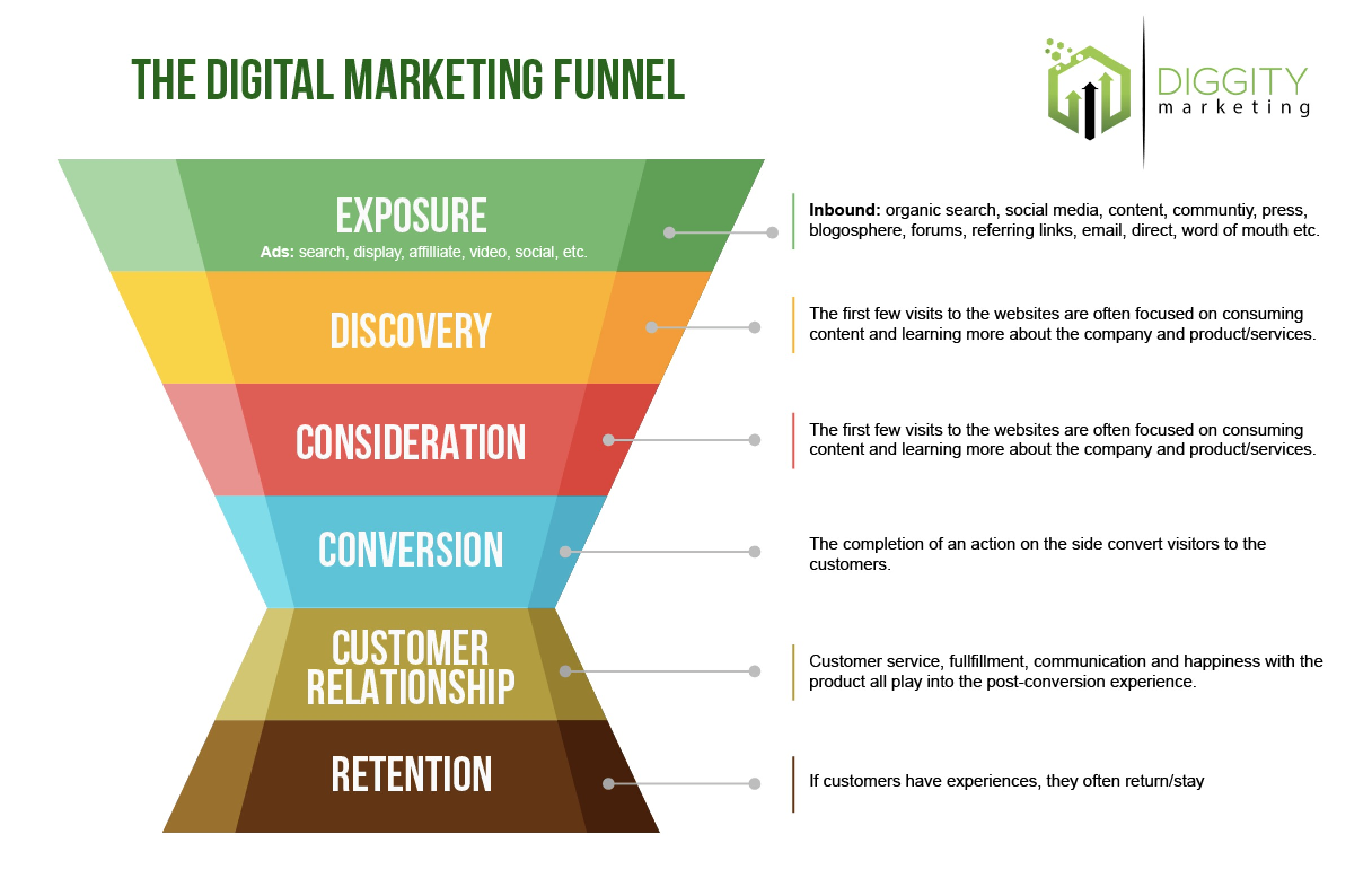
It shows a linear relationship between the number of leads at different stages and a linear customer journey that travels through Marketing, handoff to Sales, conversion, then Success and Support. In other words, this structure shows a customer moving through a company's systems in the same way as those systems are set up.
This is not how people move through your systems. Not even close.
That's a little closer to reality.
Whatever stage of your company's structure a lead might be at, they're unaware, and they could not care less.
This is as true for B2B SaaS customers as it is true for confused e-commerce shoppers who can't navigate the checkout.
Suppose you look back over your relationship with a B2B SaaS tool that you use regularly. Did you follow a linear relationship with that tool? Did this relationship look like the funnel we're all used to seeing? I'm betting you were a bit closer to the wandering movements shown in the graphic above.
How Do Your Customers Move Through Your Funnel?
If you don't know the answer to that, you can't honestly say you know how your business really works.
But if you do, you can bring common sense to your decision-making process and understand what you need to do to drive success.
If you have a budget for it, products like Segment and Zapier will let you tie your whole stack together and give you the insight necessary to understand this. Setting that process up is costly, but if your growth is at the stage to support it, it pays.
If you're not there yet, you need something more straightforward. Try this:
- Build the most complete customer profile possible — one that includes lookalikes, complete descriptions of your real best customers, and the widest range of data you can find.
- Simplify and concentrate your stack. Look for tools that already integrate and create a single customer view that moves from Marketing to Sales to Success to Retention intact, gathering relevant data as it goes. A single customer view that is less detailed is more useful than a fractured view that is more detailed.
- Build a company culture that doesn't break the customer journey down by department. Get used to Marketing and Retention teams looking into the CRM and Sales checking Success and Marketing.
- Start by seeking to attract the most profitable customers you can, and start as late into the customer journey as possible. When you understand your customer journey, you have a solid chance of identifying where customers, rather than leads or traffic, already are.
Key Takeaways
- Fix the basics first! Get your website in good working order and shore up your content marketing. While you make other plans, this stuff should continue to earn you leads and customers.
- Leverage the mid-funnel to grow per-user value and get the most from your real leads.
- Audit your content and website to attract leads, not traffic.
- Start talking to churning customers right away. The more they're worth, the more effort you should put in. Find out everything you can that you can use.
- Feed information upstream, downstream, and sideways. Engineering and Product should have the same data as Sales and Marketing, and vice versa.
- Rethink customer acquisition and retention in terms of each other.
- Learn your customer journey and start looking for real customers as close to purchase as possible.
Share on:
Facebook /
Twitter /
LinkedIn /
Reddit /
Hacker News /
Email
